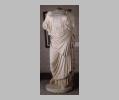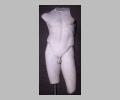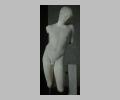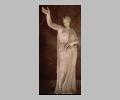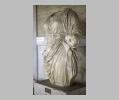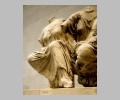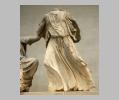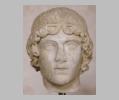The Emergence of a New Sculptural Style
Statues in the Greek Archaic Age1 had been characterized by a stiff posture imitating the style of standing
figures from Egypt. Egyptian sculptors had gone on producing this style unchanged for
centuries. Greek artists who made free-standing sculptures, on the other hand, had
begun to change their style by the time of the Persian Wars, and the fifth century
B.C. saw new poses become more prevalent in this genre, continuing an earlier
evolution toward movement visible in the
sculpture attached to temples2.
Human males were still being generally portrayed nude as athletes or
warriors3, and
women were still clothed in fine robes.4 But their postures and their physiques were evolving toward ever more
naturalistic renderings. While archaic male statues had been made striding forward
with their left legs, arms held rigidly at their sides,
male statues might now
have bent arms or the body's weight on either leg5. Their musculature was anatomically correct rather than
sketchy and
almost impressionistic6, as had been the style in the sixth century B.C. Female statues, too, now had
more
relaxed poses7 and
clothing8, which hung in such a way as to hint at the shape of the body underneath
instead of disguise it. The faces of classical sculptures, however, reflected an
impassive calm9 rather than the smiles that had characterized archaic figures.
Sculpture in Bronze
Bronze10 was the preferred material of the sculptors who devised the daring new
styles in free-standing sculpture in the fifth century, although marble was also
popular. Creating
bronze statues11, which were cast in molds made from clay models, required a particularly
well-equipped workshop with furnaces, tools, and foundry workers skilled in
metallurgy. Because sculptors and artists labored with their hands, aristocrats
regarded them as workmen of low social status, and only the most famous ones, like
Pheidias, could move in high society. Properly prepared bronze had the tensile
strength to allow outstretched poses of arms and legs, which could not be done in
marble without supports. (Hence the intrusive tree trunks and other such supporting
members introduced in the marble copies made in Roman times of Greek statues in
bronze. These Roman copies of the sort commonly seen in modern museums are often the
only surviving examples of the originals.)
The Sculpture of Myron and Polyclitus
The strength and malleability of bronze allowed innovative sculptors like the
Athenian
Myron12 and
Polyclitus13 of Argos to push the development of the free-standing
statue to its physical limits. Myron, for example, sculpted a
discus
thrower14 crouched at the top of his backswing, a pose far from
the relaxed and serene symmetry of early archaic statuary. The figure not only
assumes an asymmetrical pose but also seems to burst with the tension of the
athlete's effort. Polyclitus' renowned statue of a walking
man carrying a
spear15 is posed to give a different impression from every angle of viewing. The
feeling of motion it conveys is palpable. The same is true of the famous statue by
an unknown sculptor of a female (perhaps the goddess of love Aphrodite) adjusting
her diaphanous robe with one upraised arm. The message these statues conveyed to
their ancient audience was one of energy, motion, and asymmetry in delicate balance.
Archaic statues impressed a viewer with their appearance of stability; not even a
hard shove looked likely to budge them. Free-standing statues of the classical
period, by contrast, showed greater range in a variety of poses and impressions. The
spirited movement of some of these statues suggests the energy of the times but also
the possibility of change and instability.







